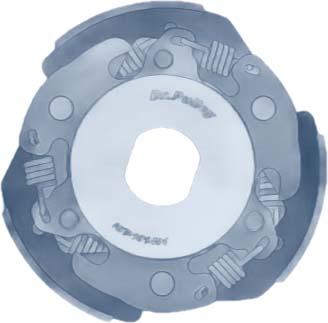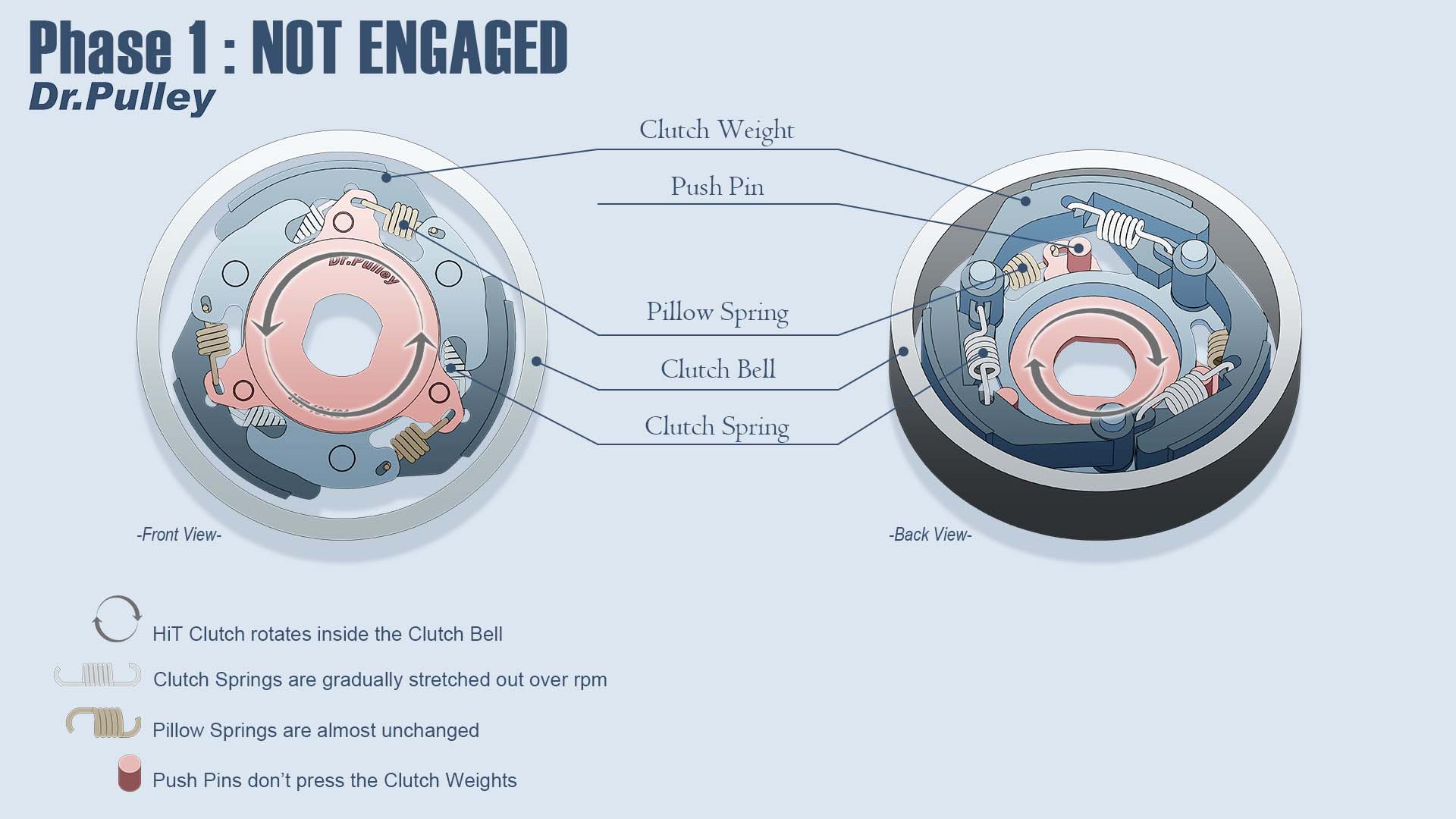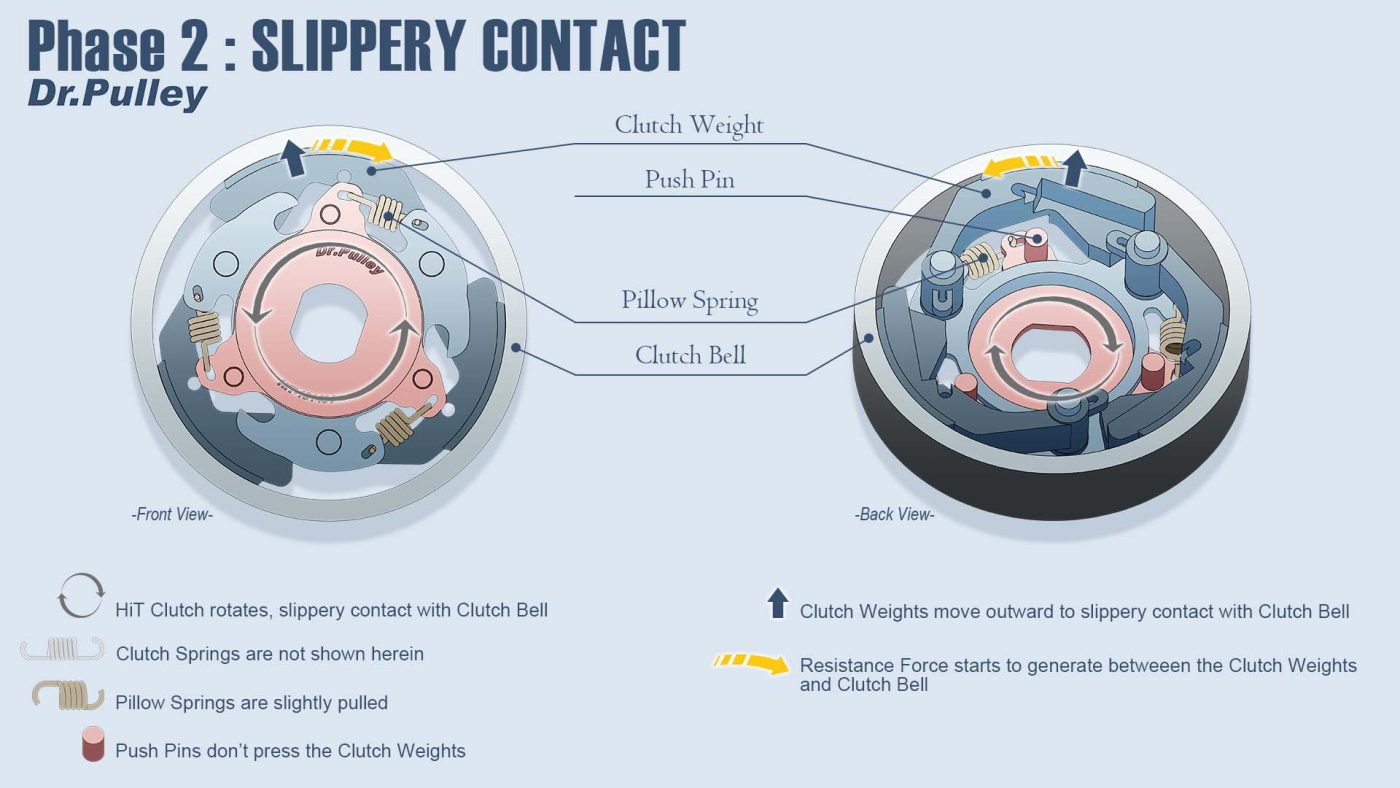Clutch
How does a HiT Clutch work

How does a HiT Clutch work?
For a vehicle to start to move, generally we know there are a few procedures, such as:
- Engine start.
- Throttle open.
- Revolution speed-up.
Afterwards the Clutch (or, more specifically, clutch weights) can firmly connect to (or engage with) the Clutch Bell and the vehicle starts to move. In fact, people often forget that there is a so-called “slippery contact” stage right before the engagement of clutch weights and the Clutch Bell. For easier understanding, we will see from the BACK VIEW and explain the following three phases:

- Not Engaged
- Slippery Contact
- Fully Engaged
In Phase I, HiT Clutch works the same as a conventional centrifugal clutch does. In Phase II, a RESISTANCE FORCE starts to generate. And then in Phase III, a FORCE (from Push Pin) works on Clutch Weights and onto Clutch Bell.
(It is recommended to see BACK VIEW as Push Pins do not show in the FRONT VIEW.)
Phase I : NOT ENGAGED
Phase I : NOT ENGAGED represents the period from the very beginning when the engine starts (and clutch rpm is zero) to the moment that Clutch Weight touches Clutch Bell. During this phase, HiT Clutch works the same as a conventional clutch. Also, the key point here is that the Clutch is in a rotating state while the Clutch Bell is in a stationary one.

Phase II : SLIPPERY CONTACT
Clutch rpm keeps going up. The centrifugal force of Clutch Weight becomes strong enough to overcome the resistance of Clutch Spring, Clutch Weights touch Clutch Bell, and then both Clutch and Clutch Bell are rotating. Initially these two parts are rotating at their own rotational speed, respectively, and they will then gradually synchronize to the same speed. The period existing after Phase I and before both Clutch and Clutch Bell synchronously rotate, is what we call Slippery Contact.
Starting from here, HiT Clutch works differently from the conventional clutches.
A resistance force is generated once Clutch Weights touched Clutch Bell, and it is opposite to the direction Clutch rotates. Since this force is not very strong at this stage, it can only slightly stretch Pillow Springs; thus Push Pins have not touched Clutch Weights yet.


Phase III : FULLY ENGAGED
Clutch rpm keeps moving up. The centrifugal force gets stronger, and Clutch Weights gain sufficient force to conquer the strength of Clutch Springs to connect Clutch Bell and rotate at the same speeds. This whole process brings to FULLY ENGAGED.
Thrust Force
While the resistance force gets stronger, Pillow Springs are pulled longer. Once Push Pins touched Clutch Weights, a thrust force is generated onto Clutch Weights, make them moving outward to firmly connect (or say, engaged with) Clutch Bell.
The stronger Pillow Springs are, the later Push Pins start to activate.
The weaker Pillow Springs are, the earlier Push Pins activate.
The stronger Pillow Springs are, the weaker the thrust force is.
On the contrary, the weaker Pillow Springs are, the stronger the thrust force is.
Conclusively speaking, Pillow Springs have three important functions:
- Transfer the rotation from Base 1 to Base 2.
- Determine when Push Pins touch Clutch Weights.
- Control the strength of the thrust force, i.e., the firmness of the engagement.

How, then, does a HiT Clutch work? Conclusively speaking, during Phase II (Slippery Contact) and Phase III (Fully Engaged), a resistance force is generated. This resistance force, opposite to the direction that HiT Clutch rotates, will extend Pillow Springs and therefore make Push Pins touch Clutch Weights, where a force is produced. The force is what we call “thrust force”, i.e., a special force which only exists in HiT Clutch, that enables much solid engagement between Clutch Weights and Clutch Bell.
More Information
Our Youtube url : https://www.youtube.com/c/DrPulley






